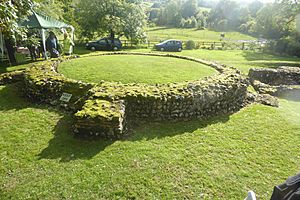Keston Roman villa facts for kids

Remains of the mausoleum
|
|
| Lua error in Module:Location_map at line 420: attempt to index field 'wikibase' (a nil value). | |
| Location | Keston, London Borough of Bromley |
|---|---|
| Type | Iron age village, Roman villa, Saxon village |
The Keston Roman villa is an exciting archaeological site. It is located in Keston, which is in the London Borough of Bromley, England. This site was once home to several buildings. One of the most important is a mausoleum, which is like a special tomb. You can still see parts of this mausoleum today!
| Top - 0-9 A B C D E F G H I J K L M N O P Q R S T U V W X Y Z |
Discovering Keston Villa
People have been exploring the Keston Roman villa for a long time. Farmers first found a large stone coffin, called a sarcophagus, around 1783.
Proper digging, also known as excavations, began in 1828. During these digs, a round mausoleum was uncovered. Another sarcophagus was found nearby. More excavations happened in 1854. This is when the main villa building was found.
Later, between 1967 and 1990, a group called the West Kent Border Archaeology Group did a lot more work. They carefully dug up and recorded the entire villa complex. Their findings helped us learn much more about this ancient place.
Life Before the Romans
The Keston site was used by people long before the Romans arrived. Some of the oldest remains are from around 2000 BC. These include tools made from flint stone.
Iron Age Settlements
Later, during the Middle Iron Age (about 600 to 200 BC), people lived here. Archaeologists found three pits from this time. These pits held pottery pieces. There were also many postholes. These are holes where wooden posts once stood. They might have been part of small buildings.
More remains are from the Late Iron Age. This period was from about 50 BC to AD 50. Many pits and postholes belong to this time. About ten groups of postholes show small rectangular buildings. These were likely raised granaries. Granaries are special buildings used to store grain.
The Roman Era Begins
The next period at Keston was the Roman time. This was from about AD 50 to 160. A small burial ground was found from this period. There were also two enclosed areas. This shows that the Iron Age settlement kept going. It continued even after the Romans took control. There was no big break in people living here.
Early Roman Villas
Around AD 160, the first proper houses were built. These were large wooden buildings. There was one in the north, one in the south, and the biggest in the west. The western building was about 16 by 6 meters. It was probably the main home of the villa complex. Pieces of plaster show that some rooms were painted. Sadly, this building burned down around AD 160.
Stone Buildings and Tombs
Around AD 200, the main western building was rebuilt. This time, it was made of stone. The new house had a bath. Some of the floors were covered with small colored tiles called tesserae. Many rooms and ceilings were painted.
A small cemetery was built in the north during the third century AD. The most important building here is a round mausoleum. It was once covered with red plaster. Two smaller structures were found next to it. Three sarcophagi were found here. One of them had decorations on the outside. Inside one of the tombs, a small lead coffin was found. It was very well preserved.
Around AD 300, the southern building was also rebuilt in stone. We are not sure what it was used for. The northern building was no longer used. The main western villa continued to be used until about AD 400.
After the Romans
There is clear proof that people still lived here after Roman rule ended. Remains of an early Saxon village were found. This village dates from about AD 450 to 550.
The site, known as "Iron Age settlement and Roman villa at Warbank, Keston," is a scheduled monument. This means it is a very important historical site.
Gallery







